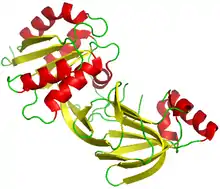Diacylglycerol kinase
Diacylglycerol kinase (DGK or DAGK) is a family of enzymes that catalyzes the conversion of diacylglycerol (DAG) to phosphatidic acid (PA), utilizing ATP as a source of the phosphate. In non-stimulated cells, DGK activity is low, allowing DAG to be used for glycerophospholipid biosynthesis, but on receptor activation of the phosphoinositide pathway, DGK activity increases, driving the conversion of DAG to PA. As both lipids are thought to function as bioactive lipid signaling molecules with distinct cellular targets, DGK therefore occupies an important position, effectively serving as a switch by terminating the signalling of one lipid while simultaneously activating signalling by another.[1]
| Diacylglycerol kinase | |||||||||
|---|---|---|---|---|---|---|---|---|---|
 DgkB, soluble DAGK from Staphylococcus aureus. α-helices in red, β-strands in yellow, coils in green. | |||||||||
| Identifiers | |||||||||
| EC number | 2.7.1.107 | ||||||||
| CAS number | 60382-71-0 | ||||||||
| Databases | |||||||||
| IntEnz | IntEnz view | ||||||||
| BRENDA | BRENDA entry | ||||||||
| ExPASy | NiceZyme view | ||||||||
| KEGG | KEGG entry | ||||||||
| MetaCyc | metabolic pathway | ||||||||
| PRIAM | profile | ||||||||
| PDB structures | RCSB PDB PDBe PDBsum | ||||||||
| |||||||||
| Prokaryotic diacylglycerol kinase | |||||||||
|---|---|---|---|---|---|---|---|---|---|
| Identifiers | |||||||||
| Symbol | DAGK_prokar | ||||||||
| Pfam | PF01219 | ||||||||
| InterPro | IPR000829 | ||||||||
| PROSITE | PDOC00820 | ||||||||
| OPM superfamily | 196 | ||||||||
| OPM protein | 4d2e | ||||||||
| |||||||||
| Diacylglycerol kinase catalytic domain | |||||||||
|---|---|---|---|---|---|---|---|---|---|
| Identifiers | |||||||||
| Symbol | DAGK_cat | ||||||||
| Pfam | PF00781 | ||||||||
| Pfam clan | CL0240 | ||||||||
| InterPro | IPR001206 | ||||||||
| SMART | DAGKc | ||||||||
| |||||||||
| Diacylglycerol kinase accessory domain | |||||||||
|---|---|---|---|---|---|---|---|---|---|
| Identifiers | |||||||||
| Symbol | DAGK_acc | ||||||||
| Pfam | PF00609 | ||||||||
| InterPro | IPR000756 | ||||||||
| SMART | DAGKa | ||||||||
| |||||||||
In bacteria, DGK is very small (13 to 15 kD) membrane protein which seems to contain three transmembrane domains.[2] The best conserved region is a stretch of 12 residues which are located in a cytoplasmic loop between the second and third transmembrane domains. Some Gram-positive bacteria also encode a soluble diacylglycerol kinase capable of reintroducing DAG into the phospholipid biosynthesis pathway. DAG accumulates in Gram-positive bacteria as a result of the transfer of glycerol-1-phosphate moieties from phosphatidylglycerol to lipotechoic acid.[3]
Mammalian DGK Isoforms
Currently, nine members of the DGK family have been cloned and identified. Although all family members have conserved catalytic domains and two cysteine rich domains, they are further classified into five groups according to the presence of additional functional domains and substrate specificity.[4] These are as follows:
- Type 1 - DGK-α, DGK-β, DGK-γ - contain EF-hand motifs and a recoverin homology domain
- Type 2 - DGK-δ, DGK-η - contain a pleckstrin homology domain
- Type 3 - DGK-ε - has specificity for arachidonate-containing DAG
- Type 4 - DGK-ζ, DGK-ι - contain a MARCKS homology domain, ankyrin repeats, a C-terminal nuclear localisation signal, and a PDZ-binding motif.
- Type 5 - DGK-θ - contains a third cysteine-rich domain, a pleckstrin homology domain and a proline rich region
References
- Mérida I, Avila-Flores A, Merino E (January 2008). "Diacylglycerol kinases: at the hub of cell signalling". The Biochemical Journal. 409 (1): 1–18. doi:10.1042/BJ20071040. PMID 18062770.
- Smith RL, O'Toole JF, Maguire ME, Sanders CR (September 1994). "Membrane topology of Escherichia coli diacylglycerol kinase". Journal of Bacteriology. 176 (17): 5459–65. doi:10.1128/jb.176.17.5459-5465.1994. PMC 196734. PMID 8071224.
- Miller DJ, Jerga A, Rock CO, White SW (July 2008). "Analysis of the Staphylococcus aureus DgkB structure reveals a common catalytic mechanism for the soluble diacylglycerol kinases". Structure. 16 (7): 1036–46. doi:10.1016/j.str.2008.03.019. PMC 2847398. PMID 18611377.
- van Blitterswijk WJ, Houssa B (October 2000). "Properties and functions of diacylglycerol kinases". Cellular Signalling. 12 (9–10): 595–605. doi:10.1016/s0898-6568(00)00113-3. PMID 11080611.
External links
- Diacylglycerol+Kinase at the US National Library of Medicine Medical Subject Headings (MeSH)
- EC 2.7.1.107